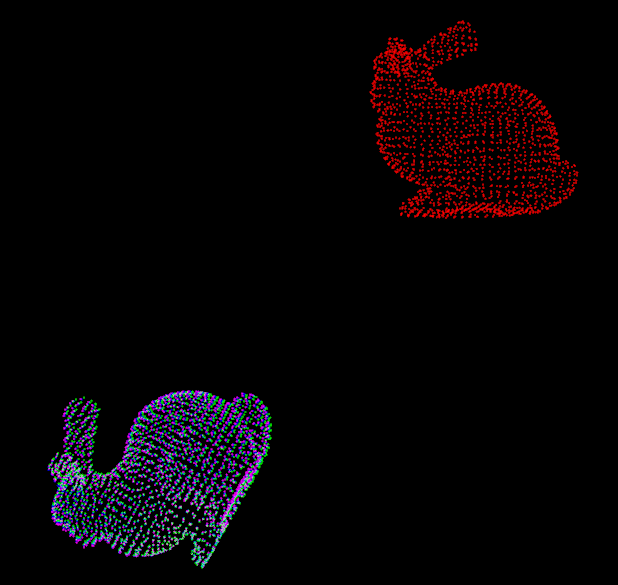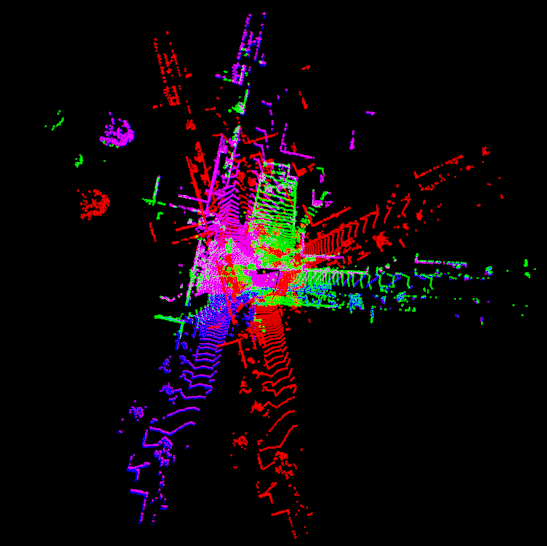Official page of "A Single Correspondence Is Enough: Robust Global Registration to Avoid Degeneracy in Urban Environments", which is accepted @ ICRA'22. NOTE that this repository is the re-implmenation, so it is not exactly same with the original version.
We provide some examples to show how to use Quatro implemented in TEASER++ library.
Originally, We provide Quatro based on Point Cloud Library (here), but we also integrate Quatro in TEASER++ library for convenience.
- Updated on 2024.01.01:
optimizedMatchinginmatcher.cppis added, which is 4 times faster than original implementation. See thequatro_cpp_fpfh_in_kittiexample.
- PCL 1.8
- Linux 18.04 LTS
Note that I copied raw files of TEASER++, which are for descriptor extraction and matching, due to the PCL version issue (Original: 1.9 / Mine: 1.8 in Ubuntu 18.04),
-
Install the original TEASER++ library. Follow the Minimal C++ example category. Quatro is included in
include/teaser/registration.h -
Then, run the following script to install this repository.
git clone git@github.com:LimHyungTae/quatro-cpp-fpfh.git
cd quatro-cpp-fpfh && mkdir build && cd build
cmake ..
make -j 8
OMP_NUM_THREADS=8 ./quatro_cpp_fpfh
(Red: source, green: target, blue: estimate from Quatro, magenta: estimate from TEASER++. The blue and magenta clouds are overlapped)
=====================================
Quatro Results
=====================================
Error (deg): 0.990611
Estimated translation (m): 0.00152444
Time taken (s): 0.010767
=====================================
TEASER++ Results
=====================================
Error (deg): 2.2537
Estimated translation (m): 0.00269122
Time taken (s): 0.012313In general, if the yaw rotation is dominant in SO(3), Quatro showed a promising performance. This is because TEASER++ is a non-minimal solver, so some undesirable roll and pitch errors happen.
The original FPFH for a 3D point cloud captured by a 64-channel LiDAR sensor takes tens of seconds, which is too slow. For this reason, we employ voxel-sampled FPFH, which is preceded by voxel-sampling. This is followed by the correspondence test.
OMP_NUM_THREADS=8 ./quatro_cpp_fpfh_in_kitti
=====================================
Quatro Results
Time taken (s): 0.046343
0.881955 0.471334 0 -8.8018
-0.471334 0.881955 0 -0.937651
0 0 1 -0.187636
0 0 0 1
=====================================
=====================================
TEASER++ Results
Time taken (s): 0.051302
0.883366 0.468621 0.00764119 -8.80745
-0.466593 0.880848 -0.07998 -0.960288
-0.044211 0.0670863 0.996767 -0.0323215
0 0 0 1
=====================================(Red: source, green: target, blue: estimate from Quatro, magenta: estimate from TEASER++. The blue and magenta clouds are overlapped)
Both methods succeeded!
Note that, optimizedMatching is way more faster than advancedMatching (0.10 < 0.42).
It may output the command lines as follows:
[Build KdTree]: 0.019237 sec
[Search using FLANN]: 0.060132 sec
[Cross checking]: 0.014097 sec
[Tuple test]: 0.005469 sec
In contrast, advancedMatching takes almost 0.45 sec, which is four time slower than my implementation.
[Build KdTree & matching]: 0.368105 sec
[Cross checking]: 0.075848 sec
[Tuple test]: 0.010516 sec
[Set unique correspondences]: 6e-06 sec
Interestingly, parallel_reduce of TBB is 7 times faster than single threading cross checking, which was implemented as:
///////////////////////////////////////////
// Original, single-threaded implementation
///////////////////////////////////////////
std::vector<std::pair<int, int>> corres;
corres.reserve(std::max(nPti, nPtj) / 4); // reserve 1/4 of the maximum number of points, which is heuristic
///////////////////////////
/// INITIAL MATCHING
///////////////////////////
for (int j = 0; j < nPtj; j++) {
// `dis` is a squared distance
if (dis[j] > thr_dist * thr_dist) { continue; }
const int &i = corres_K[j];
if (i_to_j[i] == -1) {
searchKDTree(&feature_tree_j, features_[fi][i], corres_K, dis, 1);
i_to_j[i] = corres_K[0];
if (corres_K[0] == j) {
corres.emplace_back(i, j);
}
}
}If our research has been helpful, please cite the below papers:
@article{lim2022quatro,
title={A Single Correspondence Is Enough: Robust Global Registration to Avoid Degeneracy in Urban Environments},
author={Lim, Hyungtae and Yeon, Suyong and Ryu, Suyong and Lee, Yonghan and Kim, Youngji and Yun, Jaeseong and Jung, Euigon and Lee, Donghwan and Myung, Hyun},
booktitle={Proc. IEEE Int. Conf. Robot. Autom.},
year={2022},
pages={Accepted. To appear}
}
@article{yang2020teaser,
title={{TEASER: Fast and certifiable point cloud registration}},
author={Yang, Heng and Shi, Jingnan and Carlone, Luca},
journal={IEEE Trans. on Robot.},
volume={37},
number={2},
pages={314--333},
year={2020}
}
- All codes on this page are copyrighted by KAIST published under the Creative Commons Attribution-NonCommercial-ShareAlike 4.0 License. You must attribute the work in the manner specified by the author. You may not use the work for commercial purposes, and you may only distribute the resulting work under the same license if you alter, transform, or create the work.

